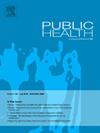纳洛酮废水水平与物质使用障碍治疗药物治疗遭遇和过量的相关性——美国加利福尼亚州马林县,2023年3月- 2024年6月
IF 3.9
3区 医学
Q1 PUBLIC, ENVIRONMENTAL & OCCUPATIONAL HEALTH
引用次数: 0
摘要
目的检测废水样本中丁丙诺啡、美沙酮、纳曲酮、纳洛酮及其代谢物,以评估与治疗遭遇和过量用药的相关性。研究设计:每周时间步的相关分析。暴露是丁丙诺啡、美沙酮、纳曲酮、纳洛酮及其代谢物的废水负荷。结果是过量死亡,阿片类药物使用障碍(mod)治疗遭遇,非致命性过量紧急医疗服务(EMS)遭遇相同,一周和两周后。方法每周采集两次(2023年2月~ 2024年6月)的废水样品,对每种分析物进行检测。生成周几何均值,并以日污水流量和人口(mg/1000人/天)归一化。计算过量死亡、OUD处理遭遇、非致命性过量EMS遭遇和废水质量负荷(相同、一周和两周后)的周计数之间的Spearman相关系数。时间序列模型,调整月度和季度季节性,用于评估纳洛酮,美沙酮和丁丙诺啡水平的趋势。结果较高的纳洛酮水平与2周后过量死亡的减少呈弱相关(- 0.2-0.3)。丁丙诺啡水平与一周后OUD治疗患者呈正相关(0.26;p = 0.03),并与两周后阿片类药物过量的EMS就诊负相关(- 0.32;p = 0.01)。每周废水中纳洛酮和mods的浓度随时间显著增加。结论对mods和纳洛酮的废水监测有助于评估治疗差距,跟踪减少过量危害和物质使用障碍治疗目标的进展。社区丁丙诺啡水平增加与过量用药减少之间的相关性突出了促进获得治疗的重要性。本文章由计算机程序翻译,如有差异,请以英文原文为准。
Correlations between wastewater levels of naloxone and substance use disorder treatment medications with treatment encounters and overdoses – Marin County, California, USA, March 2023–June 2024
Objectives
We tested wastewater samples for buprenorphine, methadone, naltrexone, naloxone, and their metabolites to assess correlations with treatment encounters and overdoses.
Study Design
Correlation analysis at the weekly time step. Exposures were wastewater mass loads of buprenorphine, methadone, naltrexone, naloxone, and their metabolites. Outcomes were overdose deaths, medications for opioid use disorder (MOUD) treatment encounters, non-fatal overdose Emergency Medical Services (EMS) encounters same, one, and two weeks later.
Methods
Wastewater samples collected twice weekly (February 2023–June 2024) were tested for each analyte. Weekly geometric means were generated and normalized by daily wastewater flow rate and population (mg/1000 people/day). Spearman's correlation coefficients were calculated between weekly counts for overdose deaths, OUD treatment encounters, non-fatal overdose EMS encounters, and wastewater mass loads (same, one, and two weeks later). Time series models, adjusting for monthly and quarterly seasonality, were used to assess trends in naloxone, methadone, and buprenorphine levels.
Results
Higher naloxone levels were weakly (−0.2-0.3) associated with fewer overdose deaths two weeks later. Buprenorphine levels were positively associated with OUD treatment clients one week later (0.26; p = 0.03), and negatively correlated with EMS encounters for opioid overdose two weeks later (−0.32; p = 0.01). Weekly wastewater concentrations of naloxone and MOUDs significantly increased over time.
Conclusions
Wastewater surveillance for MOUDs and naloxone might aid in assessing treatment gaps and tracking progress towards overdose harm reduction and substance use disorder treatment goals. Correlations between increases in community-level buprenorphine levels and reduced overdoses highlight the importance of bolstering access to treatment.
求助全文
通过发布文献求助,成功后即可免费获取论文全文。
去求助
来源期刊

Public Health
医学-公共卫生、环境卫生与职业卫生
CiteScore
7.60
自引率
0.00%
发文量
280
审稿时长
37 days
期刊介绍:
Public Health is an international, multidisciplinary peer-reviewed journal. It publishes original papers, reviews and short reports on all aspects of the science, philosophy, and practice of public health.
 求助内容:
求助内容: 应助结果提醒方式:
应助结果提醒方式:


